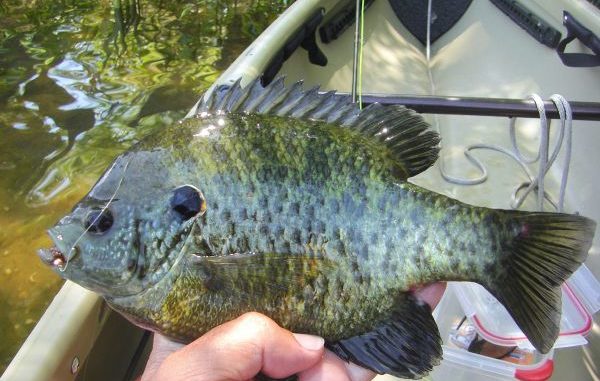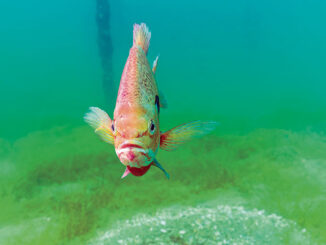
From backing to bugs — what you need to get started
This month’s topic comes courtesy of Gerald King, an Alexandria resident who enjoys pursuing those pesky sunfish otherwise known to frequent readers of this column as gobbules.
“What do I need as far as tackle to get started?” Gerald asked.
Sounds simple, right? Yes, about as simple as solving the national debt.
The problem is that, in fly fishing, there are many solutions to every situation.
Take rods, for example.
Fly rods are rated on a weight numbering system, 1 through 12. Each increment represents a progressively stiffer blank.
For example, weights 1 to 2 are considered ultralight, weights 3 to 4 light, weights 5 to 6 medium, and so on.
Rods also have a taper action. When loaded with the right length of the same numeric-designated line, a fast-action rod will bend in the tip, while a moderate action will bend in the lower section of the rod.
Add the fact that rods come in different lengths and you understand why choosing the “right” rod is more about personal taste.
So I’ll give my personal recommendations for bream tackle. I suggest you use the Internet to explore other possibilities.
Rod — My favorite is a 5-weight, either in 8- or 8 ½-foot length, in moderate action. This weight is the best overall for freshwater — light enough for fun with bream but able to land that unexpected big bass or catfish that might inhale your fly.
The moderate action is not only more fun to cast, but it’s better suited for wind-resistant popping bugs and for combination popper-dropper rigs.
Graphite rods (preferred) cost as low as $49. However, if you want one with a lifetime warranty, the TFO and Redington models start around $130.
Line — Since the line casts the lure, its weight, shape and finish are important. Lines are marked on the box with three-coded designations such as WF-6-F, L-5-F, DT-8-S.
The first code denotes the line shape: WF equals “weight forward,” L equals “level” and DT equals “double taper.”
The second code is the weight of the line.
The third code indicates it’s buoyancy: F equals “floating,” S equals “sinking” and I equals “intermediate.”
For Louisiana freshwater, a weight-forward, floating line is all you need. For your 5-weight rod, look for a line designated as WF-5-F.
Backing — Fly lines are only 60 to 100 feet in length. That’s not long enough in the event you unintentionally hook into a large bass, carp or hybrid striper.
Backing is a braided Dacron line used to connect the reel spool to the fly line to give you that extra capacity. For freshwater, 20-pound backing is sufficient.
Reel — There are a number of reels in the budget category ($30 to $100) that feature all these desired specs: aluminum construction, center-line disc drag, large arbor and quick-release spool.
Just make sure the reel “balances” the rod. That is, if the rod is 5-weight, the spool should hold 5-weight line plus at least 50 yards of backing.
Leader — This is the monofilament connection from fly line to fly. It’s usually tapered, consisting of a large diameter butt section connected to the line, a thinner midsection and an even smaller tippet section that is tied to the fly.
The purpose of a tapered leader is to efficiently transfer energy from the line to the fly so the fly hits the water a maximum distance away from the end of the fly line (less spooking the fish).
For most freshwater applications, I use a leader 6 to 8 feet long, using 18- to 24-pound mono for the butt section and 12-pound mono for the midsection.
The size of the tippet depends on the size of the fly. For this purpose, the “X” number is commonly used. There are general formulas for determining tippet size, but I’ll forego the math and make it simple: For nearly all the flies you’ll use for bream, either a 3X or 4X tippet will do.
If the flies are really small or the water super clear, then I’d go with a 5X.
Again, ask 20 fly-fishers what leaders they use for bream (or any other species) and you’ll get 20 different answers.
Flies — For bream, poppers and foam spiders on hook sizes 8 through 12 are my most-productive patterns year after year.
But if conditions do not favor surface fishing, try woolybuggers, fluff butts, cap spiders, jitterbees and beadhead nymphs. Some of these work best when suspended 2 to 3 feet under a tiny strike indicator (float).
Setup — To set up your rig, you’ll need the following knots: Duncans loop for backing to spool, Albright for fly line to backing, nail knot for leader butt to fly line, surgeons or double uni-knot for inter-leader connections, improved clinch or Duncan’s loop for fly to leader tippet.
Summary — I’ve shared the tackle, leader configuration and flies I use most often for bream. But part of the appeal of this sport is experimenting with setups, and establishing your own favorites.


